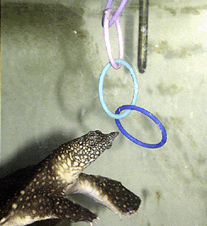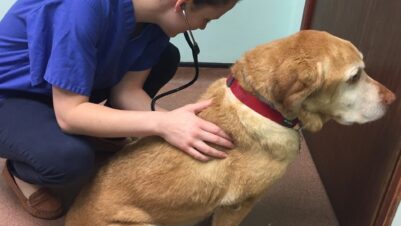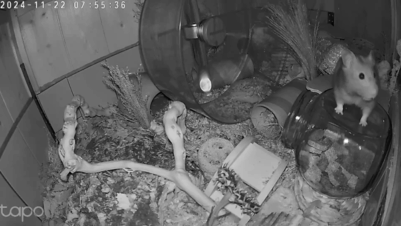
This article aims to provide an overview of how abnormal repetitive behaviours (ARBs) manifest in dogs, help practitioners understand why they come about and propose a possible roadmap that can support in owner and practitioner treatment of this debilitating behavioural problem.
What are abnormal repetitive behaviours?
ARBs are usually associated with poor welfare and a lack of or limited access to stimuli and may present in kennelled or excessively crated dogs, but this is not exclusively the case (Denham et al., 2014). Increasingly, these behavioural disorders are being seen in pet dogs with poor genetics, unmanaged or misunderstood acute and chronic stress and compounding medical issues.
Increasingly, these behavioural disorders are being seen in pet dogs with poor genetics, unmanaged or misunderstood acute and chronic stress and compounding medical issues
Unfortunately, these behavioural challenges can creep up on clients and manifest in many different ways. They are common in breeds that people refer to as “needing jobs”, “working dogs” or dogs that have a predisposition to enjoying or working in patterns (eg Collie types or gundogs). However, they can appear in any dog under the right – or rather, wrong – circumstances.
Why do ARBs appear?
ARBs appear for a number of reasons, which include (but are not limited to) stress, a mixture of stress and genetics, or mostly genetics. Importantly, ARBs can be, and usually are, compounded by health factors.
The appearance of ARBs should be taken seriously by the owner because the compulsion to enact the behaviour itself can cause stress and compromise welfare. Much of the time these behaviours present themselves because the animal is using the repetitive behaviours as a coping strategy for something else. We can surmise that the behaviour starts off feeling good or soothing and then spirals into something that the dog does as a default behaviour.
The behaviour starts off feeling good or soothing and then spirals into something that the dog does as a default
Common ARBs
Table 1 outlines the common compulsive and repetitive behaviours that may be seen in dogs (Heinrich, 2023).
| Type of behaviour | Example of behaviour |
| Movement | Spinning, tail-chasing, pacing, freezing, jumping in place and skin rippling |
| Oral | Self-licking, self-chewing, air or nose licking, flank sucking, wool sucking, fly snapping, polyphagia (excessive eating), polydipsia (excessive drinking), psychogenic alopecia (pulling out hair), pica (eating non-food items), chewing and licking objects |
| Vocalisation | Repetitive barking, whining and howling |
| Hallucinatory | Shadow or light chasing, startling, avoidance, fly snapping and air licking |
| Aggressive | Self-directed aggression (growling, biting at tail) or aggressive behaviour directed towards an object |
In reality, this is just a list of common manifestations of ARB, but as observed by behavioural practitioners, ARB appears to be any behaviour done in excess, out of context and without clear functionality. Further, these issues are increasingly seen in dogs with complex health issues, poor breeding and other compounding genetic factors (Horwitz and Landsberg, 2014).
So, to clarify, things can be done in the right context, but they can be done in the wrong way or in excess, without an end goal being achieved (eg polydipsia or polyphagia).
Whether it’s genetics or something a dog develops over time, this type of behavioural pattern or strategy needs to be addressed and, as much as possible, prevented from happening and dealt with as soon as possible.
A roadmap to treat ARBs
Let’s say you encounter a dog or animal that has presented with an ARB in clinic. There isn’t a sure-fire way of approaching it that will help or cure everything immediately. There are a lot of factors at play and scope for a number of treatment options; however, the importance of a holistic approach must be stressed.
What should you consider in your assessment?
1. An initial rule-out examination is essential
We must be able to identify any potential exacerbating factors, be they genetic disorders, injury, illness or deficiencies. This is particularly important because we could misdiagnose a stereotype when in fact the animal is ill – wouldn’t it be awful if we assumed something was a repetitive behaviour, but the dog was chewing their leg/hip because it was painful? In contrast, we know that pain or illness can exacerbate negative or coping behaviours. If we identify an injury and begin to alleviate pain, then we might begin to reduce some of the compounding factors causing the behaviour to occur.
2. What if we don’t find anything medical to further investigate or treat?
Use of medication could be considered (Horwitz & Landsberg, 2014). In this there are a few options:
- Is a pain trial an option for this dog? Can the owners effectively monitor a pain trial?
- Is psychopharmacology an option for this dog? Usually, this is an avenue to explore, due to our understanding that stress significantly impacts these behaviours
- Or, controversially, can we introduce both in the first instance? If vets agree and we are unsure of pain influence, it could be helpful to use both psychopharmacology and pain management to be sure that we are effectively tackling part of the problem. The most important thing is that we are trying to reduce the occurrence of the behaviour as a priority. With veterinary agreement, tapering of one or the other when the behaviour is more under control can help identify which is more effective
3. What immediate triage advice can we offer?
Immediate advice that we can offer in the initial assessment is to try to stop the dog from encountering the context within which they will find themselves using the behaviour. For example, a dog bites themselves when they are confined in a crate – can we avoid putting them in a crate as a first point of management? Or a dog is looking for and chasing shadows and lights – can we keep the environment as dark as possible to avoid this while we begin to address it with a professional?
4. Consider a referral to a clinical animal behaviourist
Clinical animal behaviourists will help provide comprehensive management and treatment for the behaviour. They can also liaise with you – or any relevant veterinary staff – and share information and updates on the case, including how effectively the treatment plan is working.
Final thoughts
Behavioural disorders can require lifelong management and treatment; while they may disappear for long periods, when under stressful conditions […] they can reoccur
It is important to address ARB cases with compassion and sensitivity as they impact owner welfare significantly. These behavioural disorders can require lifelong management and treatment; while they may disappear for long periods, when under stressful conditions – be that environmental, physiological or otherwise – they can reoccur.







